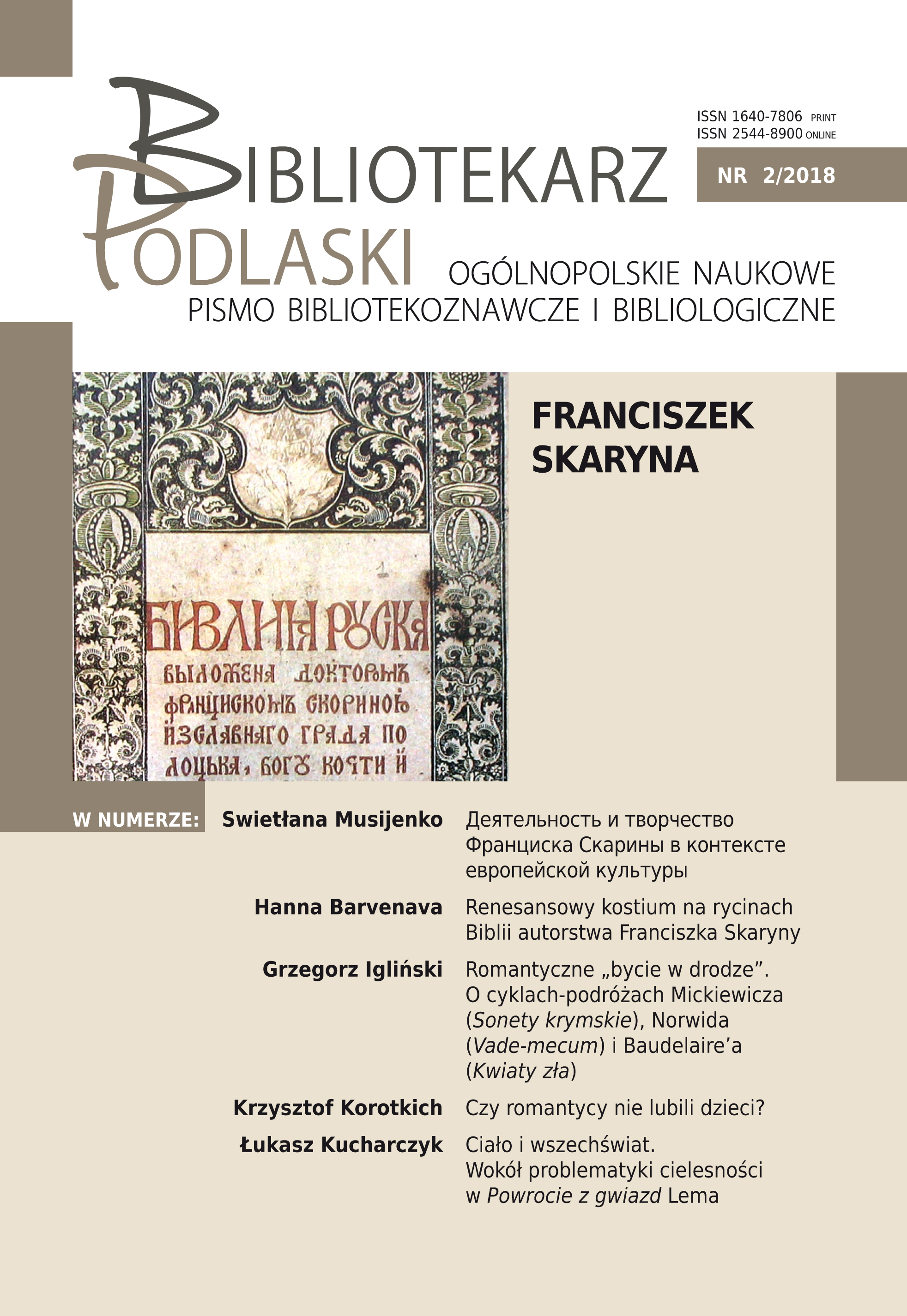Abstract
The article focuses on the Renaissance costume, which is depicted in the illustrations of the Bible published by Francysk Skaryna. The illustrations perfectly reflect the culture, fashion, and mores prevalent in the Grand Duchy of Lithuania in the 15th and 16th century. The author examines types of clothes, their fabric (wool, silk, golden silk, linen, paper, leather, plain weave), their colours (scarlet, azure, blue, red,
light blue, brown, gold, silver), their adornments (precious stones, embroidered with gold, silver as well as with wool and linen thread), etc. Concluding, he asserts that the ideal of beauty was based on the principle of rationality and naturalness, which was clearly manifested in the fashion prevalent at the time.
Moreover, the article focuses on the lexis of Skaryna’s old Belarussian. While referring to the textile industry, weaving machines, colours of fabric, adornments, regalia, he enumerates a long list of names of old clothes and parts of clothes. In the 15th and 16th century, Belarussians created their own images of Gothic and, later, Renaissance costumes, which now enrich our understanding of the Renaissance costume in Europe.
References
Барвенава, Г. А. Тэкстыль Сярэднявечча на землях Беларусі. Мінск 2008.
Біблія: Факс. ўзнаўленне Бібліі, выд. Францыскам Скарынаю ў 1517–1519 гг. Т. 1–3. Мінск, 1990–91.
Бохан, Ю. М. Узбраенне войска ВКЛ другой паловы XІV – канца XVI ст. Мінск 2002.
Валодзіна, Т. В. Семантыка рэчаў у духоўнай спадчыне беларусаў. Мінск 1999.
Дучыц, Л. У. Касцюм жыхароў Беларусі Х–ХІІІ стст.: паводле археалагічных звестак. Мінск 2005.
Забелин, И. Е. Домашний быт русских цариц в ХVI и ХVII веках. Москва 1901.
Костомаров, Н. И. Очерк домашней жизни и нравов великорусского народа в XVI и XVII столетиях. Спб 1860.
Слоўнік мовы Скарыны. Т. 1. А-О. Мінск 1977.
Слоўнік мовы Скарыны. Т. 2. П-Я. Мінск 1984.
Францыск Скарына і яго час. Энцыклапедычны даведнік. Менск 1988.
Францыск Скарына. Зборнік дакументаў і матэрыялаў / уклад. В. Дарашкевіч, Я. Неміроўскі. Менск 1988.
Францыск Скарына. 1517. Гравюра.
Гравюра “Эсфір царыца і цар Ясвер” з кнігі “Эсфір”.
Фрагмент гравюры “Царыца Саўская з царом Саламонам” з кнігі “Еклісіаст”.
Фрагмент гравюры “Дачка фараона знайшла Маісея ў вадзе” з кнігі “Выхад”.
Фрагмент гравюры “Будаўніцтва храма ў Іерусаліме” з 3-й кнігі “Царствы”.
Фрагмент гравюры “Дачка фараона знайшла Маісея ў вадзе” з кнігі “Выхад”.
Фрагмент гравюры “Будаўніцтва храма ў Іерусаліме” з 3-й кнігі “Царствы”.
Барвенава Ганна. Жаночы касцюм Жыхароў Вялікага княства Літоўскага XVI ст. Рэканструкцыя. Музей гісторыі Магілёва.
Барвенава Ганна. Мужчынскі касцюм Жыхароў Вялікага княства Літоўскага XVI ст. Рэканструкцыя. Музей гісторыі Магілёва.
Barvenava G. A., Tèkstylʹ Sârèdnâvečča na zemlâh Belarusì, Mìnsk 2008.
Bìblìâ: Faks. ŭznaŭlenne Bìblìì, vyd. Francyskam Skarynaû ŭ 1517–1519 gg., t. 1–3, Mìnsk 1990–1991.
Bohan Û. M., Uzbraenne vojska VKL drugoj palovy XIV – kanca XVI st., Mìnsk 2002.
Dyčyc L. U., Kascûm žyharoŭ Belarusì X–XIII stst.: pavodle arhealagìčnyh zvestak, Mìnsk 2005.
Francysk Skaryna i âgo čas. Êncyklapedyčny davednìk, Mensk 1998.
Francysk Skaryna. Zbornìk dakumentaŭ ì materyâlaŭ / uklad. V. Daraškevič, Nemìroŭskì, Mensk 1998.
Kostomarov N. I., Očerk domašnej žizni i nravov velikorusskogo naroda XVI i XVII stoletiâh, SPb. 1860.
Sloŭnìk movy Skaryny, t. 1: A–O, Mìnsk 1977.
Sloŭnìk movy Skaryny, t. 2: P–Â, Mìnsk 1984.
Valodzìna T. V., Semantyka rèčaŭ u duhoŭnaj spadčyne belarusaŭ, Mìnsk 1999.
Zabelin I. E., Domašnij byt russkih caric v XVI i XVII vekah, Moskva 1901.
Articles published in the “gold open access” mode on the basis of a non-exclusive license agreement between the publisher and the author. Permitted use:
- the publication may be read and stored on any device,
- the publication may be cited (with obligatory reference to the author, the title of the text, as well as the full title, bibliographic address of the issue and page of the journal)
The editorial team of “Bibliotekarz Podlaski” implements an open access policy by publishing materials in the form of the so-called Gold Open Access. From volume 42 (issue 1/2019), the journal is available under the Creative Commons license (Attribution – ShareAlike: CC BY-SA).
The key declarations of the Open Access and Open Science movement, which we fully support, are available on the CEON Open Science website.
COPYRIGHT:
The editorial team of “Bibliotekarz Podlaski” implements an open access policy by publishing materials in the form of the so-called Gold Open Access. The journal is available under the Creative Commons license – Attribution – ShareAlike 4.0: International: CC BY-SA 4.0).
The key declarations of the Open Access and Open Science movement, which we fully support, are available on the CEON Open Science website.
“Bibliotekarz Podlaski” allows its readers to read, download, copy, distribute, print, search and link to the full content of articles. We enable full, immediate, unlimited (both in a territorial, temporal and technical sense) open access to all published content, in accordance with the principle that freely available research increases and accelerates the global development of science and the exchange of knowledge.
The editorial team of “Bibliotekarz Podlaski” encourages authors to place articles published in the journal in open repositories (after the review or the final version of the publisher), provided that a link to the journal’s website is provided.
The journal does not charge the authors any fees for accepting and publishing their texts.

